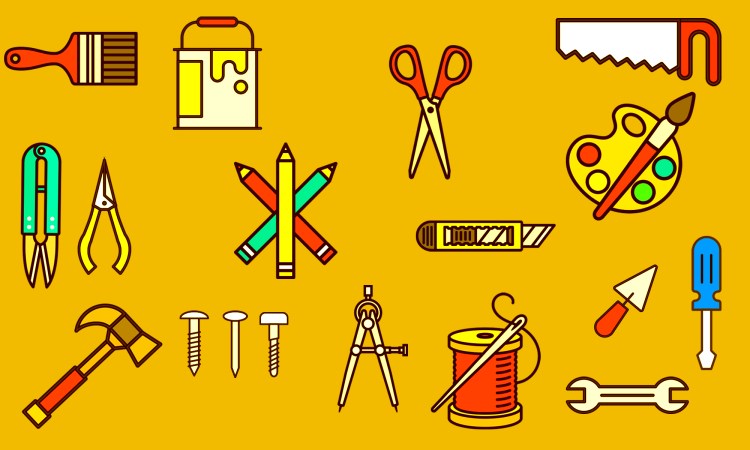
Special-effects designer and Mythbuster Adam Savage offers a call to action and vision map to every would-be maker and dreamer out there.
“How do I get started?” Across four decades of making, I’m asked this question more than any other. At an individual project level, my answer is “Well, it depends” — on unique concerns like the mental physics of inertia, momentum, structural cohesion, friction, fracture and so on.
But most of the time, the question really being asked is, “How do I get started when I don’t even know what to make?” And I’ve come to believe the answer resides in the first law of thermodynamics: An object at rest tends to stay at rest unless acted upon by an outside force. In other words, to get started you need to become the outside force which starts the mental and physical ball rolling. You need to overcome the inertia of inaction and indecision and begin developing some creative momentum.
I’ve rarely had an issue getting moving, and I have a pretty easy time coming up with ideas. This might make me unique in some maker circles — and infuriating in others — but I assure you this has less to do with any special skill and more to do with one specific trait: Obsession.
Obsession is the gravity of making. It moves things, binds them together, and gives them structure.
Bringing anything into the world requires at least a little helping of obsession. Obsession is the gravity of making. It moves things, binds them together, and gives them structure. Passion (the good side of obsession) can create great things (like ideas), but if it becomes too singular of a fixation (the bad side of obsession), it can be destructive. Which result you’ll experience depends largely on how you discover, engage with, and manage your obsessions.
I’ve always been a curious person. Countless things have captured my attention, including history, science fiction, film, the architecture of public spaces, monsters, mechanical computers, glue, Legos, curse words, magic, storytelling, Star Wars, and on and on.
Thankfully, I had early support from my parents who encouraged my natural interests. My dad was an artist, and my mom was a psychotherapist. If I was curious about something, they gave me permission to explore. When I didn’t know how, they made the tools of exploration available. But they didn’t want me pursuing every new, shiny thing simply because it was novel; they felt it was more beneficial for me to pay close attention to the things I actually liked, that made me feel something. They knew that if I let those feelings guide me, I would be more likely to do something with the fruits of that exploration.
Emotional self-awareness is a tall task for a kid. Hell, it’s tough when you’re an adult. The pubescent teen me had no idea how to describe what Star Wars or science fiction made me feel, so I kept my enthusiasms and feelings to myself. But in keeping my feelings secret, I did not bottle them up and extinguish them, as can be the case. Instead, I let them multiply inside me until they were all I could think about.
Over the years, I have lost count of how many people have come up to me and admitted to their own curiosity about something I’ve done or a hobby I pursue.
Secret thrills can come from anywhere and anything at any time. It might be the villain’s weapon in a Bond film you’re watching for the 20th time or the unique patina created by thousands of hands over decades on a bronze train station railing. If you’re paying attention, those things will catch your eye, and if you let them, they’ll engage your mind. Once in a while they will thrill you enough to feed a desire to go deeper into that thing, to know more about it, and possibly to possess and do something with it. Obsessions like these are where ideas come from.
In my experience, when you follow that secret thrill, ideas pop out from the woodwork as the force of your interest pulls you down the rabbit hole. And yet, so few of us give that thrill much attention. We dismiss it as an indulgence or distraction. There’s almost a quiet shame in it, which is a big part of the reason why that secret thrill always remains so secret for so many.
Over the years, I have lost count of how many people have come up to me and quietly, almost reluctantly, admitted to their own curiosity about something I’ve done or a hobby I pursue. There is a belief among many that to jump with both feet into something like that is to play hooky from the important details of life. But I would argue that these pursuits are the important parts of life. They are passions, they have purpose, and I have learned to pay genuine respect and put our energy into places that can serve us and give us joy.
Each of us has a unique way we share our stories, and we express them differently. How does your brain work?
I’ve been fortunate in that I’ve been able to follow my secret thrills into adulthood and into professional success. But even if I hadn’t been able to do that for a living, I would still constantly make stuff. This stands in stark contrast to other fleeting interests that I used to pursue, like juggling or dramatic performance, which I’d give up on once I got a notch better than mediocre. With those, I never knew how to push past that point of proficiency and didn’t care enough to find out. I was the Patron Saint of Mediocrity+1.
When I realized that I could pursue, and maybe reach, real excellence at a high level of making, that’s when I dove in head first. And that pursuit has improved my ability to acquire other skills. It’s also made me more comfortable with acknowledging my limits. For instance, I would love to be a writer of screenplays. A screenwriter’s way of seeing is a special thing — they have a unique type of brain, one that filters the world entirely through narrative and becomes a highly-tuned machine of character construction, world building, and plot layering.
But I’ve learned that’s not how my brain works. I don’t think in arcs or twisting plots. When I tell people, they often say, “You just need to come up with a good idea and then you’ll be off and running — no problem.” Except they’re missing the point. I’m okay with how my brain works; I don’t need to write screenplays.
Each of us ends up building different ways to interpret and recapitulate the world as we make our way through it. Each of us has a unique way we share our stories, and we express them differently. How does your brain work? What is your secret thrill? How do you process your world?
I am a maker by trade and a storyteller by temperament, but first I see myself as a “permission machine.” In the beginning of his essay “Self-Reliance,” Ralph Waldo Emerson writes: “To believe your own thought, to believe that what is true for you in your private heart is true for all men — that is genius.” That essay and phrase hit me hard in the solar plexus when I first heard it at 18, and it continues today.
The deepest truths about your experience are universal truths that connect each of us to each other and to the world around us. I have found it to be the key that unlocks those chains of shame and self-doubt. It gives you the room to fly your freak flag and the mental space to pay attention to the things that you’re interested in. It is the permission that you are looking for and I wish to offer you: To follow those peculiar aspects of the world that give you a secret thrill. For the creator within all of us, this is the pathway to ideas and creation.
We all have brains and the ability to do remarkable things with them, but what we do with them is up to each of us.
Every single one of us is trying to make sense of the world: Our place in it and how everything fits together. We learn as much about ourselves and our surroundings from the stories we choose to tell, as from the stories that others tell us. Sure, sometimes the source of our own stories can be slightly embarrassing. I recognize cosplay — the practice of dressing up as favorite characters from movies, fiction and anime and which is foremost among my passions for making stuff — is not exactly the most useful and noble endeavor in the world. I don’t delude myself into thinking that by doing it I’m necessarily making the world a better place. However, in paying attention to what engages me and sharing with others what happens when I do, what I am doing is producing things that might spark ideas or inspiration for others, just as others’ work can spark ideas for me.
How I’ve come up with my stories and how I get ideas for what to make often come from my love of movies. But your ideas can come from anywhere. Being attuned to those pings of interest is the duty of a creator, whether you’re a scientist coming up with a hypothesis, an artist with a blank canvas in front of you, or a troubadour with a quiet guitar in your hands. We all have brains and the ability to do remarkable things with them, but what we do with them is up to each of us.
Beyond that, there is no magic formula for getting started, I promise. It merely requires that you participate in your world, that you pay attention to what interests you, that you follow the thrills they produce, and that you’re never afraid to go deep on them, to obsess over them, to dig through the bottom of the rabbit hole if necessary — and to find that great idea which has been waiting there for you all along.
Excerpted from Every Tool’s a Hammer: Life Is What You Make It by Adam Savage. Reprinted with permission of Atria Books, an imprint of Simon & Schuster, Inc. Copyright © 2019 by Adam Savage and Drew Curtis.
Watch his TED Talk now:












